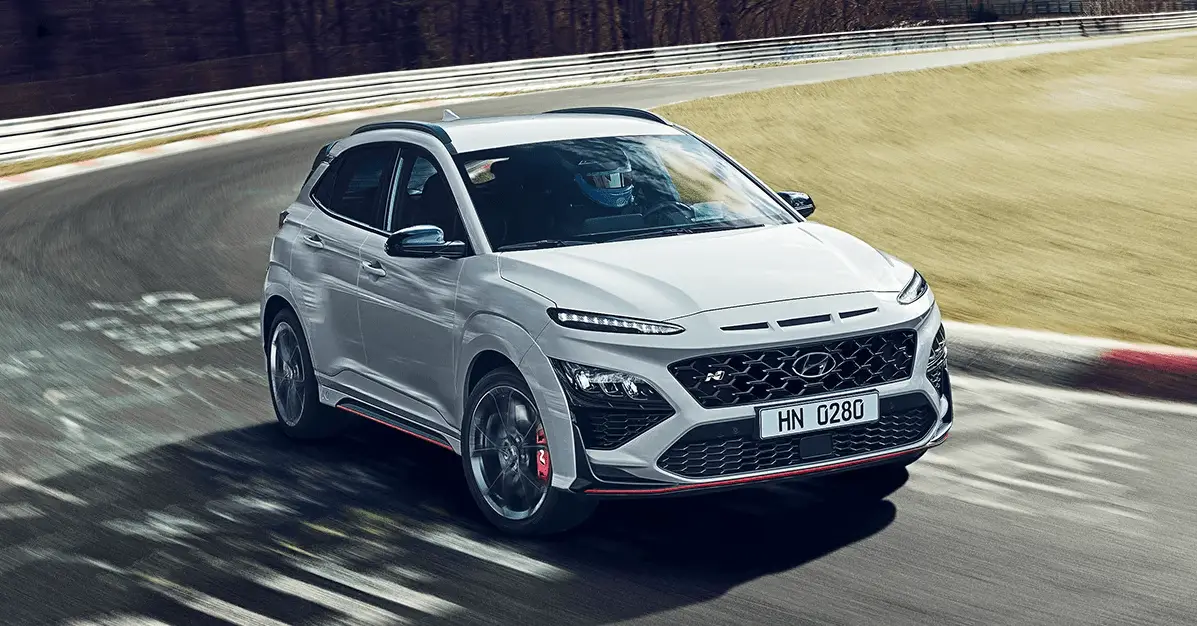Hyundai Kona-N 2023 High Beam Assist (HBA)
With its sophisticated High Beam Assist technology, the 2023 Hyundai Kona-N raises the bar for safety and convenience when driving at night. This technology, which makes use of sophisticated sensors and cameras, smoothly recognizes approaching cars and modifies the high lights on the car to provide the best possible road illumination without blinding other motorists. The 2023 Kona-N’s High Beam Assist is a useful addition to this high-performance small SUV. It allows drivers to enjoy improved vision during nighttime travels while also exhibiting a dedication to safety and concern for other road users.
2023 Hyundai KONA Specs, Price, Features, Milage (Brochure)
High Beam Assist (HBA)
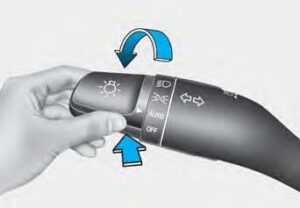
High Beam Assist will automatically adjust the headlight range (switches between high beam and low beam) depending on the brightness of detected vehicles and certain road conditions.
Detecting sensor (Front view camera)
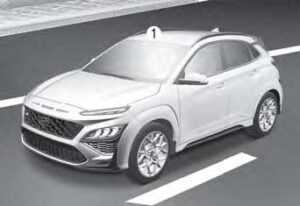
[1] : Front view camera
The front view camera is used as a detecting sensor to detect ambient light and brightness while driving. Refer to the picture above for the detailed location of the detecting sensor.
NOTICE
Always keep the front view camera in good condition to maintain the optimal performance of High Beam Assist. For more details on the precautions of the front view camera, refer to the “Forward Collision-Avoidance Assist (FCA)” section in chapter 7.
High Beam Assist Setting
Setting features
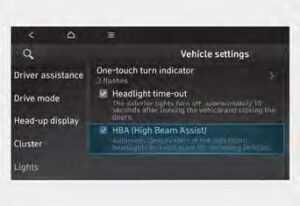
WITH the engine on, select Light, High Beam Assist’ from the Settings menu to turn on High Beam Assist and deselect to turn off the function.
WARNING
For your safety, change the Settings after parking the vehicle at a safe location.
High Beam Assist Operation
Display and control
- After selecting ‘High Beam Assist’ in the Settings menu, High Beam Assist will operate by following the procedure below.
- Place the headlight switch in the AUTO position and push the headlight lever towards the instrument cluster. The High Beam Assist ( ) indicator light will illuminate on the cluster and High Beam Assist will be enabled.
- When High Beam Assist is enabled, the high beam will turn on when the vehicle speed is above 25 mph (40 km/h). When the vehicle speed is below 15 mph (25 km/h), the high beam will turn off.
- The High Beam ( ) indicator light will illuminate on the cluster when the high beam is on.
- When High Beam Assist is operating, if the headlight lever or switch is used, High Beam Assist operates as follows:
- If the headlight lever is pulled towards you when the high beam is off, the high beam will turn on without High Beam Assist canceled. When you let go of the headlight lever, the lever will move to the middle and the high beam will turn off.
- If the headlight lever is pulled towards you when the high beam is on by High Beam Assist, the low beam will turn on and High Beam Assist will turn off.
- If the headlight switch is placed from AUTO to another position (headlight/position/off), High Beam Assist will turn off and the corresponding lamp will turn on.
- When High Beam Assist is operating, high beam switches to low beam if any of the following conditions occur:
- When the headlight of an oncoming vehicle is detected.
- When the tail lamp of a vehicle in front is detected.
- When the headlight or tail lamp of a motorcycle or a bicycle is detected.
- When the surrounding ambient light is bright enough that high beams are not required.
- When streetlights or other lights are detected.
High Beam Assist Malfunction and Limitations
High Beam Assist malfunction
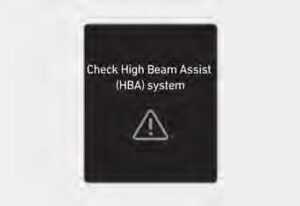
When High Beam Assist is not working properly, the ‘Check High Beam Assist (HBA) system’ warning message will appear and the ( )warning light will illuminate the cluster. Has the vehicle been inspected by an authorized HYUNDAI dealer?
Limitations of High Beam Assist
High Beam Assist may not work properly in the following situations:
- Light from an oncoming or front vehicle is not detected because of lamp damage, or because it is hidden from sight, etc.
- The headlight of an oncoming or front vehicle is covered with dust, snow or water.
- A front vehicle’s headlights are off, but the fog lamps are on, etc.
- There is a lamp that has a similar shape as a vehicle’s lamp.
- Headlights have been damaged or not repaired properly.
- Headlights are not aimed properly.
- Driving on a narrow-curved road, rough road, uphill or downhill.
- The vehicle in front is partially visible on a crossroad or curved road.
- There is a traffic light, reflecting sign, flashing sign or mirror ahead.
- There is a temporary reflector or flash ahead (construction area).
- The road conditions are bad such as being wet, iced or covered with snow.
- A vehicle suddenly appears from a curve.
- The vehicle is tilted from a flat tire or is being towed.
- Light from an oncoming or front vehicle is not detected due to obstacles in the air such as exhaust fume, smoke, fog, snow, or water spaying or blizzard on the road, or fogging in the lamp, etc.
Information
For more details on the limitations of the front view camera, refer to the “Forward Collision-Avoidance Assist (FCA)” section in Chapter 7.
WARNING
At times, High Beam Assist may not work properly. High Beam Assist is for your convenience only. It is the responsibility of the driver for safe driving practices and always check the road conditions for your safety. When High Beam Assist does not operate properly, change the headlight position manually between the high beam and the low beam.
[1] : Front view camera
The front view camera is used as a detecting sensor to detect ambient light and brightness while driving. Refer to the picture above for the detailed location of the detecting sensor.
NOTICE
Always keep the front view camera in good condition to maintain the optimal performance of High Beam Assist. For more details on the precautions of the front view camera, refer to the “Forward Collision-Avoidance Assist (FCA)” section in Chapter 7.
FAQ
High Beam Assist (HBA) is an advanced feature in the Hyundai Kona-N 2023 that automatically adjusts the vehicle’s headlights between high and low beams based on the surrounding conditions.
The HBA system uses sensors, such as a front-facing camera or a light sensor, to detect oncoming vehicles or vehicles in front of the Kona-N. It then automatically switches between high and low beams to provide optimal visibility without blinding other drivers.
Yes, you can override the HBA system and manually control the high beams if desired. However, the system is designed to automatically manage the headlights for your convenience and safety.
No, the HBA system is primarily designed for low-light conditions or nighttime driving. It may not function during daylight hours since the sensors rely on detecting specific light conditions.
The HBA system requires proper functioning of the front-facing camera or light sensor, so it’s important to keep these components clean and free from obstructions for optimal performance.
The primary purpose of the HBA system is to detect and respond to oncoming vehicles. It may not specifically detect pedestrians or objects on the road.
The sensitivity of the HBA system may be adjustable, depending on the vehicle’s settings. You can consult the vehicle’s owner’s manual or the onboard display system to customize the HBA settings.
The HBA system is designed to provide optimal visibility in various driving conditions. However, extreme weather conditions, such as heavy rain, fog, or snow, may affect its performance.
Yes, most vehicles equipped with the HBA system allow you to enable or disable it according to your preference. You can usually find this option in the vehicle settings menu.
The availability of the HBA system may vary based on the specific trim level and optional packages. It is recommended to check with the dealership or review the vehicle’s specifications to confirm its availability.
The HBA system does not require any specific maintenance. However, it’s essential to keep the sensors clean and clear to ensure accurate detection and proper functioning.
While the HBA system is primarily designed to detect vehicles, it may also detect motorcycles or bicycles under certain conditions. However, the system’s effectiveness may vary depending on the size and visibility of these objects.
The HBA system typically does not provide a separate warning to the driver. Instead, it automatically adjusts the high beams to low beams or vice versa to avoid glaring other drivers.
Retrofitting the HBA system to older Hyundai Kona models may not be possible or feasible.
Useful Link
View Full User Guide: Hyundai Kona-N 2023 User Guide
Download Manuals: https://owners.hyundaiusa.com/us/en/resources/manuals-warranties.html
2023 Hyundai KONA Specs, Price, Features, Milage (Brochure)

